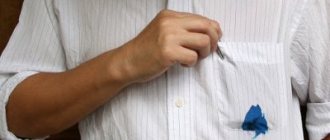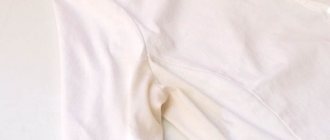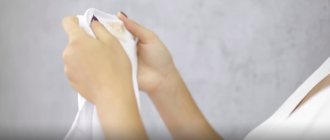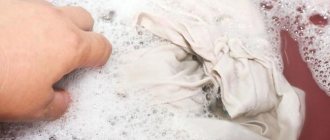The collar is one of the most important parts of a shirt, which is easy to stain and difficult to wash.
Depending on the type of contamination, you can choose a homemade recipe to eliminate the problem or use household chemicals.
In this article we will tell you how to wash the collar of a white or colored men's or women's shirt at home from the yellow stripe on it.
How to wash a white shirt collar at home
Returning the original color to the collar of a white shirt should be approached separately. Often, if you don’t pay enough attention to it, you can find that after washing there are traces of grease or other contaminants.
To avoid this, it is recommended to follow the following washing procedure:
- Try not to wear shirts for more than one day. Despite their visual cleanliness, during wear they absorb traces of dirt and sweat; dirty shirts are much more difficult to wash and have an unpleasant odor.
- Before washing, sort items by shade and texture of fabric. If you do not know how the fabric behaves when washed and whether it fades, wash such items separately. Clothes that are similar in color, if they do not fade, can be washed together. So, by turning off the spin function, at a low temperature you can wash the blue shirt from dirt along with the white one.
- Don't shy away from surface cleaning; rub the shirt with a brush to remove dead skin and external dirt.
- When washing, follow the recommendations on the label.
- Delicate fabrics are best cleaned without using a washing machine.
- Before washing, it is necessary to wash the white collar from visible traces of dirt and soak the clothes briefly.
- When soaking clothes, try to completely immerse them in water, otherwise there is a risk of streaks.
- Pay attention to what exactly you plan to wash your clothes with. You can bleach the collar of a white shirt at home using a variety of means. Today, modern manufacturers offer a large selection of different household laundry products; make sure that they are suitable for the required color and fabric.
Special remedies for stains on the collar
Special products can deal with any stains and stubborn dirt.
Belive Eco stain remover
Can be used for white and colored shirts.
Add 35 g of stain remover to 1.5-2 liters of water. For best results, use water with a temperature of 40 - 50 degrees.
The oxygen bleach contained in the stain remover is safe for health, environmentally friendly, and does not damage fabrics when washed or soaked.
Washing booster CHISTOWN
It removes sweat stains on the collar well.
Add 35 g of enhancer to 1.5-2 liters of water. Finish the collar. Suitable water temperature is 40 - 50 degrees.
CHISTOWN oxygen wash enhancer safely whitens white items and preserves the colors of colored items with regular use.
How to wash a white shirt collar
- The most common option for removing stains on a shirt is to use stain removers. Professional cleaning products are made taking into account the characteristics of the fabric and perfectly remove traces of any dirt from clothes.
- Laundry soap is also excellent for hand washing and soaking.
- White or bleach will help you wash the collar and cuffs of a white shirt. Unfortunately, they are not suitable for all types of fabric.
- Dirt on the collar can be easily washed off from white clothes using folk remedies. Baking soda, hydrogen peroxide, citric acid, or even dishwashing detergent will help you cope with this task.
Features for white, black, colored items
Once you've sorted your shirts into black, colored and white, you'll need to apply a different washing approach to each batch.
All collars can be washed with universal household chemicals . But the best result is achieved when the preparations intended specifically for them are used for white and black shirts.
Laundry detergents that are intended for white clothes contain bleach, which allows you not only to wash the shirt, but also to maintain its whiteness. Their use on shirts of a different color is prohibited.
Laundry preparations that are designed for black and dark clothes help remove stains and maintain the richness of the dark shade . These products are not used for light-colored products.
If there are few black or white shirts and they are rarely used, you can purchase an economy package of small-volume detergent.
Household chemicals
First, make sure that using your cleaning product will not damage the fabric. To do this, read the washing instructions written on the tag.
Clothes made from delicate fabrics and synthetics should not be cleaned with chlorine-containing or bleaching agents. Oxygen-based whitening is suitable for these purposes. Apply a small amount of this bleach to the yellowed areas of the collar and let stand for 5-10 minutes. Then wash the shirt.
Sweat and excess sebum form the main stains on the collar. Regular shampoo can remove them. Dilute a little shampoo in warm water and apply the solution to the stains.
After 20 minutes, the shirt can be washed in any convenient way.
For particularly difficult stains, use special products such as Antipyatin soap. Apply it to dirty areas and leave for half an hour, then rinse the item thoroughly.
To clean fresh stains, you can use dishwashing detergents. Using a sponge and warm water, whip up foam, apply it to the stain and apply lightly, then rinse under running water.
Preparing for washing
Fresh stains on the collar can be washed off by pre-soaking .
Warm water with grated laundry soap dissolved in it (at the rate of 5 liters of liquid 3 tablespoons of soap shavings) or any usual laundry detergent is suitable for these purposes. The shirt is immersed in the resulting solution for an hour (for delicate fabrics - 15-30 minutes). After soaking, the shirt is wrung out and washed as usual.
For cases when there is no time for soaking before washing, a suitable option is to soap the collar with laundry soap and brush it . After this, the item is put aside for a quarter of an hour. And then it should be washed entirely - in a machine or by hand.
But if such methods do not bring the desired result, folk recipes and store-bought stain removers will come to the rescue.
General guidelines for washing shirts are provided here.
Available means
When for some reason it is impossible to use special household chemicals, you can make do with improvised means:
- Regular lemon juice will help you clean your collar easily. Wipe the dirt with a slice of lemon and after 10-20 minutes, rinse it in running, warm water. This will help get rid of visible dirt.
- Such products as talc, starch, baby powder mixed with table salt will help clean stains. The proportions should be one to one, and the amount should be sufficient to cover the stain completely. A few hours before washing, treat the collar of your shirt with it; immediately before washing, you need to clean the desired areas from the mixture with a brush.
- Using a soft cloth or piece of cotton wool, apply table vinegar to the collar, and after 10-20 minutes, rinse it under running water. With its help you can easily remove greasy stains from a shirt. You can also add a little vinegar to the washing machine drum during washing, it will soften the water.
- A solution of water and hydrogen peroxide in equal proportions is excellent in combating stains on the collar. Using a soft cloth, apply it to the dirt and after 5 minutes rinse with water.
Top 3 special tools
Household chemicals that are designed to remove stains will also help tidy up shirt collars. The top 3 products included drugs that have proven themselves well among housewives.
Vanish OXI Action
Vanish OXI Action for stain removal is one of the products that can help remove stains on white and colored shirts . A distinctive feature of the composition is the content of active oxygen.
This component has an effective effect on contamination, literally pushing it out of the fibers of the material. Depending on the purpose of use, you can choose a product with a convenient consistency: from liquid to powder.
Advantages of use:
- maintaining the brightness of colored fabrics;
- good removal of contaminants, especially fresh ones;
- Can be used as a supplement during the main wash cycle.
Disadvantages of the product:
- uneconomical consumption;
- specific smell;
- high price (from 150 rubles per bottle of 0.45 l);
- may show low effectiveness against old stains.
Instructions for use:
- Using a dispenser, apply the gel to the collar.
- Using the bottom of a cup or a brush, rub the area of contamination.
- Place the shirt in the drum of the washing machine.
- Pour detergent into a container for washing powder and add Vanish, measuring according to the instructions.
- After washing, hang the shirt on hangers.
Bos plus Maximum
This product has proven itself well as a budget stain remover. It is advisable to use it only on white shirts.
Advantages of the product:
- reasonable price (from 60 rubles per pack of 0.25 kg);
- stain removal efficiency;
- bleaching white items;
- can be used as a booster for regular laundry detergent;
- Possibility of use in non-hot water.
Cons: Only suitable for white shirts.
Soaking instructions:
- Fill a container with 10 liters. water.
- Measure out 2 times less washing powder or gel than usual.
- Dissolve it in water.
- Add 40 to 55 grams of Bos to the water.
- Stir.
- Place the shirt in the container for 20 minutes.
- Wash as usual, adding Bos powder.
- Rinse.
- Hang to dry on hangers.
Snowter pencil
The stain remover comes in pencil form. The compact shape makes it easy to remove stains without soaking in water.
Advantages:
- affordable price (from 55 rubles per piece);
- efficiency;
- availability;
- copes even with old stains;
- ease of use.
Minuses:
- may cause discoloration;
- cannot be used without gloves.
Instructions for use:
- Wet the collar of the shirt.
- Rub a pencil along the glossy fold until foam forms.
- After a quarter of an hour, rinse in water.
- Wash the entire shirt.
Features of removing various contaminants
When removing stains for greater efficiency, you should also take into account the type of specific stain and remove it in the best possible way:
- Products containing acids will help remove grease stains from the collar of a white shirt.
- Bleach will cope with most stains, provided that their use does not damage the fabric.
- Traces of food can be removed with simple washing powder or laundry soap.
If there is particularly heavy soiling, it is necessary to soak the shirt, having previously washed away the stains on it.
Useful tips
How to wash yellow stripes on a collar? To keep your shirt white for a long time and not have problems with washing capricious collars and cuffs, remember the following:
- It is advisable to change shirts daily so that the collar does not get dirty and there are no old stains. This will help preserve the appearance of your things for a long time.
- When purchasing a shirt, carefully study the label to choose the appropriate mode and temperature for this fabric, as well as select stain removal products.
- Before washing, it is recommended to rub the shirt with a soft clothes brush to remove dead skin flakes. These particles collect dust and sweat, and then these places are difficult to wash.
- It is recommended to treat stubborn stains from the inside.
- White shirts should not be washed together with colored items.
- Oxygen bleach must be added during each wash. For severe stains, liquid bleach is recommended. Powdered bleach will perfectly remove traces of light stains.
- When pre-soaking, immerse the item completely in the solution to avoid streaks.
- The washing temperature should not be less than 40 degrees, otherwise stains may remain.
- Follow the rules of hygiene, take a shower on time, then sweat and fat will be washed off, and your clothes will get less dirty.
Important! Coffee, cigarettes, alcohol, spicy and fatty foods can not only harm your health, but also increase sweating. Accordingly, shirts will get dirty faster.
Removing old stains
When it was not possible to clean the shirt in time and the dirt has become embedded in the structure of the fabric, it is much more difficult to remove yellow stains on the collar.
We offer several of the simplest and most effective ways to deal with old stains:
- Grate a quarter of a piece of laundry soap and dissolve them in warm water. Treat the stain with soap or toothpaste, then soak the shirt for several hours in the prepared solution. Wash and rinse the item until dirt and soap traces are completely removed.
- This method is only suitable for white shirts made of non-delicate fabric. To do this, prepare a solution containing table salt along with ammonia; ammonia perfectly removes dirt from white things, but it can have a strong effect on the structure of the fabric.
- The required proportion of salt and alcohol is 1 to 4. Wash particularly strong stains with the solution, then rinse the item thoroughly. It is necessary to dry clothes after such washing in the fresh air.
Cleansing in 30 minutes
To clean heavily soiled fabric, it is necessary to use more aggressive components.
Dishwashing gel, shampoo for oily hair, anti-stain soap - these products can remove and break down greasy stains on the collar and cuff of a shirt.
Dishwashing gel
Before washing, apply the gel to the yellow stripe on the collar, rub a little and soak in hot water for 30 minutes. After soaking, wash and rinse. You can use shampoo for oily hair as a cleanser - the effect will be the same.
Brush and soap (laundry and other)
Grate half a bar of soap on a coarse grater. Dissolve it in hot water and soak your shirt in the solution. When using liquid laundry soap, no preliminary dissolution is required. For particularly difficult stains, apply a concentrated solution of soap and gently, in a circular motion, rub it with a brush on the shirt.
How to remove makeup stains on a collar
Baking soda and lemon juice will help remove traces of makeup from cuffs and collars. Cosmetics, especially high-quality ones, are strongly absorbed into the fabric. First, wash off such stains with laundry soap, then mix baking soda and lemon juice until it becomes a thick porridge.
Rub the resulting mixture into the stain until traces of cosmetics “float”; when the stain begins to spread, shake off the old mixture and apply a new one. Repeat the process until the item is completely clean.
After which you need to do normal washing.
Turpentine will help dissolve even the most stubborn makeup. Apply a little turpentine to a rag and work the stain on the back of the garment until it begins to spread. Use a dry napkin to blot the stain from the front side, transferring some of the cosmetics onto it, and change the napkin as it gets dirty.
Before washing white items, get rid of stains, otherwise there is a risk that traces of cosmetics will “transfer” to other items.
Basic rules for washing and care
I want your family members to always look clean and tidy. But, having worn a shirt just once, a person cannot help but stain either the collar or the cuffs.
Sebum and sweat are firmly eaten into the fabric, coming into contact with it repeatedly. And if a man works at a desk, then the cuffs get dirty not only inside, but also outside.
As a result, these places require especially careful washing. At the same time, you cannot rub the cuffs and collar too much, because they will lose their shape. In order for the item to last as long as possible, you should listen to the basic rules of care.
General recommendations
- When buying a shirt in a store, be sure to pay attention to the label. There are fabrics that under no circumstances can be washed either in a washing machine or by hand, but only in dry cleaning, for example, viscose or dark silk. Perhaps this circumstance will cool your ardor, and you will purchase a more easy-to-maintain model. If it is written that washing is by hand only, then you will have to put the item in order that way.
- It is not recommended to wash white and colored laundry together and at the same temperature. Everyone knows this, but sometimes they do not follow this rule. If the label on the shirt indicates that the temperature is no more than 40 degrees, then you cannot wash the item along with the jeans at 60.
- Cotton and linen shirts should be hung on a hanger after washing. This way there will be no traces of the rope left and the product will not lose its appearance, the collar will retain its shape longer.
- It is not recommended to store worn items in a closet because sweat particles can attract moths. For prevention, place cloves in a bag in a corner of the shelf.
- Try to stock up on the required number of shirts for each day so that they do not wear out. Or make sure that you have at least two new and clean pieces in stock.
How to maintain the look of a collar
A few general recommendations on how to keep your collar and shirt looking neat:
- Remember that shirts are worn for no more than one day.
- Before washing your shirt in the machine, fasten all zippers and buttons.
- Always make sure to properly wash and iron your shirt according to the manufacturer's recommendations.
- Ironing is safer on the reverse side.
- When washing, add a little vinegar or water softener.
- LG washing machine UE error what does it mean
- How to dry clothes in an apartment without a balcony
Lightening of synthetics
Synthetic fabrics are one of the most delicate materials.
Use the following tools:
- Aspirin . For 1 shirt you need to take 2-3 tablets. Grind to a powder. Rub into damp cloth. Wash after achieving the desired result.
- Potato . Peel the tuber, cut in half. Rub the desired areas well. Wait until completely dry. Get rid of remaining starch with a brush. After such treatment, wash items in the standard way.
What you should always remember
To ensure that white clothes, and especially collars, always remain well-groomed, you should strictly follow the rules. It’s clear that rules and prohibitions exist everywhere, and you don’t really want to comply with them, but this is only for the good.
Therefore, having understood and accepted their necessity, it will be quite simple to comply if you want to wear snow-white things without stains and unnecessary odors:
- White shirts should be changed daily. In summer, it is advisable to do it at least twice a day. Then put it in the wash.
- Every day, when you come home, you don’t just need to put the item in the basket with dirty laundry, but immediately soak it in a warm soapy solution.
- It is not advisable to wash white items in a machine. It is better to wash it with your hands, using either a special powder for white clothes or laundry soap without additives.
- Always dry white shirts thoroughly. Do not iron them wet. This is how you change the color from white to gray or yellow.
- White shirts should only be dried in sunlight and indoors.
- Always hang on a trempel. This will make it much easier to iron even if the item gets wrinkled during a trip and you have to use improvised means. Such methods exist.
- Soaking is a mandatory ritual before washing. It cannot be canceled. The soaking time should not be less than 2 hours.
White shirts are very sensitive to washing. Even the most expensive item can lose its snow-white color after the first cleaning. First of all, the cuffs and collar become gray: these places get dirty faster and after washing they lose their presentable appearance. You can remove dirt without harming the item if you follow simple tips.
How to deal with the problem using folk remedies
To return these parts of men's clothing to their pristine cleanliness, you don’t have to immediately grab expensive, advertised stain removers. You can successfully solve the problem with the help of improvised means. There are several proven ways to do this. For example, you may find it useful:
- soap and plastic bag;
- vinegar;
- ammonia;
- dishwashing liquid;
- talc, etc.
The main advantage of all these methods is that you don’t have to work hard with brushes. That is, actively use friction, which can destroy fabric fibers in places where it is washed most often. This means that abrasions will not appear so soon, and the clothes will last longer. Isn’t this what every thrifty housewife strives for?
Soap and package
This method has been tried by many housewives and has proven its effectiveness, although it is very simple. But everything ingenious is simple! Regular laundry soap and the “greenhouse effect” of polyethylene can dissolve stubborn stains.
Wet the collar in hot water, wring it out and thoroughly rub the stains with laundry soap. Place the product in a suitable sized plastic bag, tie it tightly and leave it like that for about an hour and a half. Now hand wash, rinse and dry the shirt thoroughly. Surprised by the effect? Your man will certainly appreciate the result.
Vinegar
Important! Before using vinegar on fabric, first test how it behaves on an inconspicuous area: aggressive acid can “eat” the color. Therefore, it is safer to use it on white fabrics.
Ammonia
Another simple and yet effective solution to the problem is to use an aqueous solution of salt and ammonia. They can be found in the kitchen and medicine cabinet in any home.
Take salt, water and alcohol in proportions 1:4:4. Wipe the stains with the resulting composition and leave to act for 10–15 minutes. After this, you can send the item to the wash.
Dishwashing liquid
Regular dishwasher detergent is also a good helper in the fight to keep the dirtiest parts of men's shirts clean. These spots are nothing more than the sweat and fat secretions of our skin, on which dust has settled. With a variety of options to choose from, try this one. At least it's safer for colored items than vinegar or ammonia.
Just wet the item and generously soak the dirty areas with dishwashing liquid. Leave it in this form, let the product act on the fatty component of the stains for about 30–40 minutes. After this, you can safely put the shirt in the washing machine - the washing powder will finish the fight against dust and dirt, which now, after dissolving the fats, will become much more accessible to it.
Talc
This option is suitable for light stains; heavily greasy areas may not be cleaned using this method. But if the shirt is fairly fresh, with minor stains, simple talc will definitely help you. Lapels can be washed with the same products as collars.
Moisten the contaminated areas with water and sprinkle generously with talcum powder. Leave it like this overnight so that this white powder has time to properly adsorb the fat from the fabric. In the morning, remove the dirty talc, put it in the machine and wash it on a suitable cycle, as usual.
Unusual ways
Toothpaste - to the rescue!
Suitable for fresh stains.
- Soak the collar in cold water.
- Apply a thick layer of toothpaste to the underside.
- Leave for half an hour, then apply another layer and scrub the area with a brush.
- After 3-5 times, the mark will completely disappear from the fabric.
A detergent for washing not only dishes, but also collars
Yes, and dish soap is good for fighting stains. To do this you need:
- a teaspoon of dishwashing detergent (liquid);
- 4 tablespoons of hydrogen peroxide;
- 3 tablespoons of soda;
- mix together and apply to stains.
After 30 minutes, rinse off the mixture and continue washing the shirt as usual.
Folk remedies didn't help? Hello chemistry!
Some stains on collars become so deeply embedded in the fabric that only chemicals can remove them.
The most gentle option is oxygen bleach. The segment is very diverse, as is the pricing policy. The cost of the most budget-friendly one does not exceed 100 rubles. And what’s most interesting is that they really work and are even more effective than advertised brands. They are used economically and last a long time.
A more aggressive agent is whiteness. It will not only remove stains, but also disinfect the fabric. Be sure to keep an eye on the time and strictly follow the instructions. otherwise, you may seriously damage the shirt.
Recommendations for washing shirt collars
- Never try to rub out a stain, especially if it is fresh. This will only complicate the situation and rub the fatty components into the deep layers of the collar tissue.
- Work only with gloves, especially if you decide to use chemicals.
- When using dishwashing detergent or chemicals, rinse the fabric thoroughly before putting the shirt in the washing machine. These components can lead to the formation of excessive foam and damage to parts.
- Try to remove the stain as quickly as possible. The longer it remains without soaking, the more difficult it is to remove.
- Change your shirts daily.
- Rough brushes and abrasives are prohibited from using on fabrics such as silk, wool, and suede.
By following these simple recommendations, you won’t have to get rid of your favorite shirt because of stains and spend money on buying a new one.
';document.body.appendChild(d);document.pnctLoadStarted=(new%20Date()).getTime();document.pnctCnclLoad=function(){document.pnctLoadStarted=0;pl=document.getElementById('pnctPreloader' );if(pl)pl.parentNode.removeChild(pl)};document.getElementById('pnctCancelBtn').addEventListener('click',function(e){e.preventDefault();document.pnctCnclLoad()}); setTimeout(function(){var%20st=document.pnctLoadStarted;if(st>0&&((new%20Date()).getTime()-st>=14000)){document.pnctCnclLoad();alert('%3C %3F%3DYii%3A%3At%28%22uniprogy%22%2C+%22Unfortunately%2C+the+image+search+is+not+available.%22%29%3F%3E')}},15000);var %20e=document.createElement('script');e.setAttribute('type','text/javascript');e.setAttribute('charset','UTF-8′);e.setAttribute('src', '//postila.ru/post.js?ver=1&m=b&rnd='+Math.random()*99999999);document.body.appendChild(e)})());">











